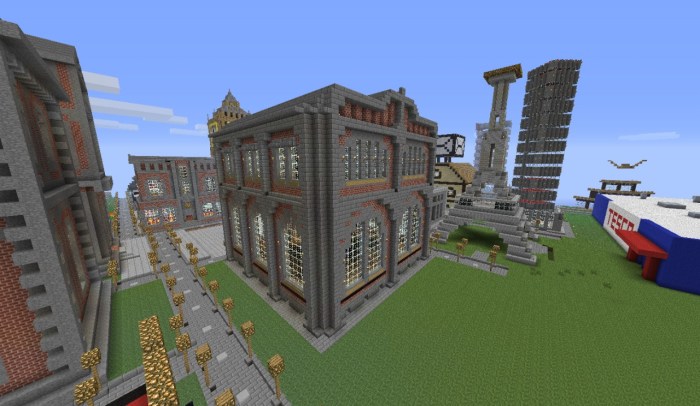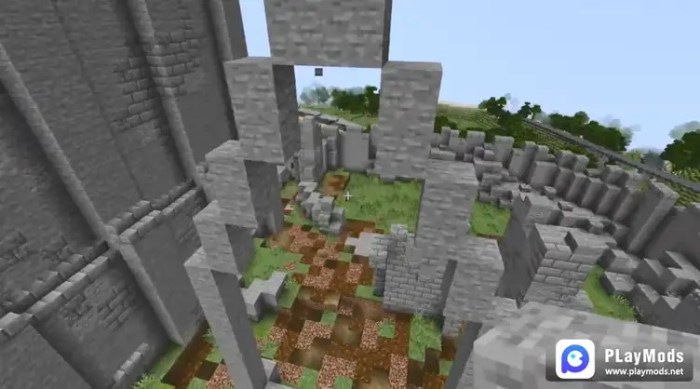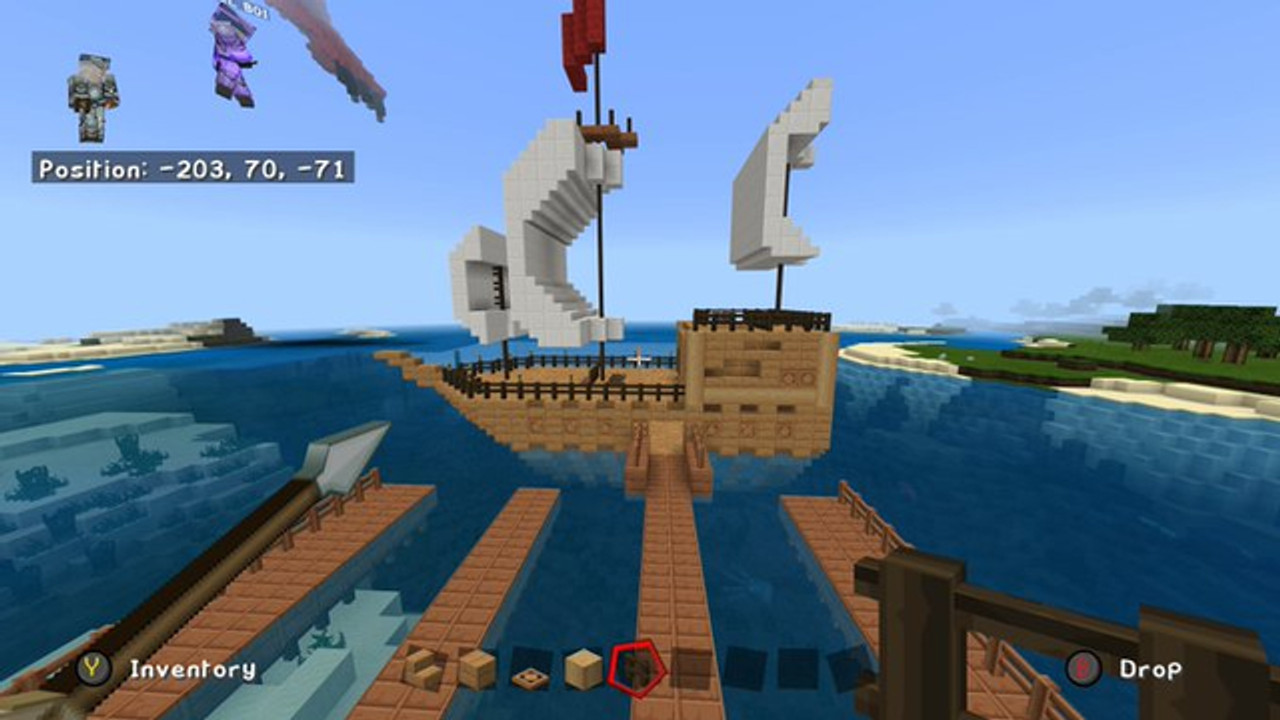Imagine stepping into ancient Rome, exploring the pyramids of Egypt, or even walking through the bustling streets of medieval London, all within the familiar world of Minecraft. Historical Reconstructions in 3D Minecraft for Educational Projects is doing just that, using the popular game to create immersive and engaging learning experiences for students of all ages.
This approach is gaining momentum, as educators discover the power of Minecraft to bring history to life, encouraging students to actively participate in the learning process.
By building intricate models of historical sites and structures, students can delve into the past, learning about architecture, geography, and the cultural context of different civilizations. This hands-on approach not only fosters a deeper understanding of history but also develops valuable skills in problem-solving, creativity, and collaboration.
The Rise of 3D Minecraft for Education
Minecraft, a game known for its open-world sandbox environment and creative possibilities, has transcended its status as a mere entertainment platform and has found a valuable niche in educational settings. The game’s unique blend of creativity, problem-solving, and collaboration has proven to be a powerful tool for engaging students and fostering their learning.The use of Minecraft for historical reconstructions offers a unique and interactive approach to learning about the past.
By building virtual replicas of historical sites, structures, and environments, students can immerse themselves in different eras and gain a deeper understanding of history.
Benefits of Minecraft for Historical Reconstructions
Minecraft’s versatility as a platform for historical reconstructions lies in its ability to engage students in a hands-on and collaborative manner. The benefits are numerous:
- Immersive Learning:Students can explore and interact with historical environments, gaining a more visceral understanding of the past.
- Collaborative Learning:Students can work together to build historical structures, fostering teamwork and communication skills.
- Creative Expression:Minecraft allows students to express their creativity while learning about history, encouraging them to think critically and creatively.
- Problem-Solving Skills:Reconstructing historical structures requires students to apply critical thinking and problem-solving skills.
- Accessibility and Affordability:Minecraft is widely accessible, with both free and paid versions, making it a cost-effective tool for educators.
Examples of Educational Projects
Several educational projects have leveraged the power of Minecraft to create engaging historical learning experiences:
- The Minecraft Medieval Village:This project involves students building a medieval village based on historical research. Students learn about medieval architecture, social structures, and daily life.
- The Ancient Egyptian Pyramid:This project challenges students to design and build a pyramid based on historical information about Egyptian architecture and construction techniques.
- The Roman Colosseum:Students can create a virtual replica of the Colosseum, learning about Roman engineering, architecture, and the history of gladiatorial combat.
Historical Reconstructions in Minecraft

Minecraft, beyond being a popular video game, has emerged as a powerful tool for educational purposes. One of its fascinating applications is in the realm of historical reconstructions, allowing learners to interact with and learn from the past in a captivating and engaging way.
Methods for Creating Historical Reconstructions in Minecraft
Creating historically accurate reconstructions in Minecraft requires a combination of creative skills and a deep understanding of the past. Several methods can be employed to achieve this.
Historical reconstructions in 3D Minecraft for educational projects can be a fun and engaging way to learn about the past. But for those with older computers, finding a texture pack that doesn’t bog down the game can be a challenge.
Luckily, there are plenty of low-end friendly 3D texture packs out there, like the ones found on Top Low-End Friendly 3D Texture Packs for Minecraft , which can enhance the visual experience without sacrificing performance. With a great texture pack, your students can explore ancient civilizations, walk through medieval castles, or even build their own historical structures, making learning history more immersive and memorable.
- Research and Planning: Thorough research is crucial to ensure historical accuracy. This involves studying historical texts, maps, architectural plans, and archaeological evidence to gather information about the structures, landscapes, and artifacts of the period being reconstructed. This research provides a foundation for the reconstruction process.
- Resource Packs and Mods: Minecraft offers a wide array of resource packs and mods that can enhance the historical reconstruction process. These resources can provide custom textures, blocks, and items that accurately reflect the materials and styles of the past. For example, resource packs can introduce historical building materials like Roman brick, medieval timber, or ancient Egyptian sandstone, while mods can add historical features like working catapults, siege engines, or even ancient Egyptian hieroglyphs.
- Building Techniques: The building techniques employed in Minecraft can be adapted to create historically accurate structures. For instance, replicating traditional building techniques like post-and-beam construction, bricklaying, or stone masonry can add authenticity to the reconstruction. Advanced players can even utilize Redstone, Minecraft’s internal circuitry system, to create working mechanisms, such as water mills, windmills, or even rudimentary plumbing systems.
Tools and Resources for Historical Reconstructions
Numerous tools and resources can aid in creating accurate historical models in Minecraft.
- Historical Databases and Archives: Online databases and archives, such as the British Museum’s online collection or the Smithsonian Institution’s digital archives, offer vast resources for historical research. These resources provide access to images, descriptions, and even 3D models of historical artifacts and structures, which can be used as reference materials for Minecraft reconstructions.
- Architectural Plans and Blueprints: Architectural plans and blueprints, often available online or in libraries, can provide detailed information about the design and construction of historical buildings. These plans can be used as a guide to accurately recreate the dimensions, layout, and structural features of historical structures in Minecraft.
- Historical Maps: Maps from the historical period being reconstructed can be invaluable for recreating the landscape, topography, and settlement patterns of the past. These maps can help in placing buildings, roads, and other features in their accurate historical context.
Importance of Research and Historical Accuracy
Research and historical accuracy are paramount in creating meaningful and educational historical reconstructions in Minecraft.
“Historical accuracy is not just about getting the details right; it’s about ensuring that the reconstruction accurately reflects the historical context and understanding of the period being represented.”
- Educational Value: Accurate historical reconstructions provide learners with a tangible and interactive experience of the past. By exploring these reconstructions, learners can develop a deeper understanding of historical events, cultures, and societies. They can gain insights into the lives of people who lived in the past, the challenges they faced, and the technologies they developed.
- Historical Awareness: Accurate reconstructions can help foster historical awareness and appreciation. They can challenge misconceptions and promote critical thinking about the past. By engaging with the past in a creative and interactive way, learners can develop a more nuanced understanding of history and its relevance to the present.
Educational Applications of Minecraft Reconstructions
Minecraft’s ability to create immersive 3D environments makes it a valuable tool for historical reconstructions. These reconstructions offer a unique and engaging way for students to learn about the past, bringing history to life in a way that traditional textbooks cannot.
Engaging Learning Experiences
Minecraft reconstructions can enhance student engagement and learning by providing a hands-on, interactive experience. Students can explore historical sites, build structures, and interact with virtual environments, fostering a deeper understanding of historical events and concepts. For example, students can explore a virtual reconstruction of the Roman Colosseum, experiencing its grandeur and understanding its role in Roman society.
This immersive experience allows them to connect with the past in a more meaningful way than simply reading about it in a textbook.
Multidisciplinary Learning
Minecraft reconstructions are not limited to history; they can be used to teach a variety of subjects. For instance, students can learn about geography by building virtual models of different landscapes, exploring the relationship between geography and historical events. In architecture, students can design and construct historical buildings, learning about different architectural styles and techniques.
Examples of Minecraft Reconstructions in Education
Here are some examples of how Minecraft reconstructions can be used for teaching different subjects:
- History:Students can recreate historical events, such as the Battle of Gettysburg, allowing them to visualize the scale and complexity of the event. They can also build historical structures, such as the Great Wall of China, learning about the engineering and cultural significance of these landmarks.
- Geography:Students can create virtual maps of different regions, exploring the relationship between geography and history. They can also build models of different geological formations, such as volcanoes and glaciers, understanding the processes that shape our planet.
- Architecture:Students can design and construct historical buildings, such as the Parthenon or the Taj Mahal, learning about different architectural styles and techniques. They can also experiment with different building materials and construction methods, understanding the challenges and innovations of historical architecture.
Creating Engaging and Interactive Experiences

Minecraft reconstructions are not just static replicas of historical sites; they can be transformed into dynamic learning environments. By incorporating interactive elements, these reconstructions can captivate students’ imaginations and encourage active participation in the learning process.
Interactive Elements Enhance Learning
Interactive elements within Minecraft reconstructions can enhance learning in various ways. These elements can provide students with opportunities to explore, experiment, and engage with the historical environment in a hands-on manner.
- Interactive Tutorials and Information Panels:Imagine walking through the Colosseum in Rome and encountering information panels that explain the structure’s construction, the gladiatorial games, or the social dynamics of Roman society. These interactive panels can be triggered by approaching them, providing students with immediate access to relevant information.
- Interactive Puzzles and Challenges:Students can be challenged to solve puzzles related to historical events, such as deciphering ancient scripts, navigating a labyrinth, or identifying artifacts. These challenges encourage critical thinking and problem-solving skills.
- Interactive Simulations:Minecraft reconstructions can be used to create interactive simulations of historical events, such as a battle scene or a trade route. Students can participate in these simulations, gaining a deeper understanding of the event’s dynamics and consequences.
Creating Engaging Quests, Challenges, and Storylines
Quests, challenges, and storylines within the historical environment can create a sense of adventure and purpose for students. These elements can be designed to guide students through the reconstruction, encouraging them to explore different aspects of the historical period.
- Historical Quests:Students can be tasked with completing quests that require them to gather information, solve problems, or interact with historical figures. For example, a quest could involve researching the life of a famous historical figure, such as Cleopatra or Julius Caesar, or completing a task related to a specific historical event, such as the building of the Great Wall of China.
- Challenges:Students can be challenged to build structures, design systems, or complete tasks that reflect the challenges faced by people in the historical period. For example, they could be tasked with designing a water system for an ancient city, constructing a Roman aqueduct, or building a Viking longship.
- Storylines:Minecraft reconstructions can be used to create engaging storylines that immerse students in the historical period. These storylines can be based on real historical events, fictional narratives, or a combination of both. For example, a storyline could follow the journey of a Roman soldier during the Roman Republic, or the life of a young woman in medieval Europe.
Fostering Collaboration and Critical Thinking Skills
Interactive elements within Minecraft reconstructions can foster collaboration and critical thinking skills among students.
- Collaborative Quests and Challenges:Students can work together in teams to complete quests, solve challenges, and build structures. This collaborative approach encourages communication, teamwork, and problem-solving skills.
- Critical Thinking Through Interaction:Interactive elements can prompt students to think critically about the historical environment and the events that took place within it. For example, students might be asked to analyze the layout of a city, the design of a building, or the purpose of a particular artifact.
This critical thinking process helps students to develop a deeper understanding of the historical period.
Case Studies and Examples of Successful Projects
The power of Minecraft historical reconstructions is best illustrated through successful projects undertaken by educational institutions. These projects offer valuable insights into the effectiveness of this approach and its impact on student learning and engagement.
Examples of Successful Projects
Several educational institutions have implemented Minecraft historical reconstruction projects with impressive results. These projects demonstrate the versatility and effectiveness of Minecraft as a tool for engaging students in historical learning.
- The Roman Forum Reconstruction at the University of California, Berkeley:This project involved students in the Department of Classics recreating the Roman Forum in Minecraft. The project aimed to deepen student understanding of Roman architecture, urban planning, and social life. Students collaborated to research, design, and build the Forum, using Minecraft’s tools to accurately represent the historical structures and their arrangement.
The project culminated in a virtual tour of the reconstructed Forum, allowing students to explore and interact with the historical environment in a unique and immersive way.
- The Viking Village Reconstruction at the University of Oslo:This project, led by the Department of Archaeology, involved students in recreating a Viking village in Minecraft. The project aimed to enhance student understanding of Viking culture, daily life, and social organization. Students collaborated to research historical sources, design buildings, and populate the village with virtual Viking characters.
The project provided a platform for students to engage in historical research, problem-solving, and creative expression.
- The Medieval Castle Reconstruction at the University of Cambridge:This project, led by the Department of History, involved students in recreating a medieval castle in Minecraft. The project aimed to enhance student understanding of medieval architecture, warfare, and social hierarchy. Students collaborated to research historical sources, design the castle, and populate it with virtual characters.
The project provided a platform for students to engage in historical research, problem-solving, and creative expression.
Future Directions and Potential Applications: Historical Reconstructions In 3D Minecraft For Educational Projects

The field of educational Minecraft reconstructions is constantly evolving, with exciting possibilities for expanding its reach and impact. The future holds the potential for more complex simulations, enhanced interactivity through VR and AR integration, and a deeper understanding of historical events.
Simulations and Research
The use of Minecraft for historical simulations has the potential to move beyond simple reconstructions to encompass more complex and nuanced historical processes. By integrating game mechanics and data-driven models, researchers can create simulations that allow for the exploration of historical events and their consequences in a dynamic and interactive way.
These simulations could incorporate factors such as population growth, resource management, economic development, and political decision-making, offering insights into historical trends and the impact of various choices.
For example, a simulation of the Roman Empire could model the impact of trade routes, military campaigns, and political policies on the growth and decline of the empire.
Virtual and Augmented Reality Integration, Historical Reconstructions in 3D Minecraft for Educational Projects
The integration of virtual reality (VR) and augmented reality (AR) technologies with Minecraft reconstructions opens up new possibilities for immersive and engaging learning experiences. VR environments can allow students to step into the past, exploring historical sites and interacting with historical figures in a way that is not possible with traditional learning methods.
AR overlays can bring historical reconstructions to life in the real world, allowing students to see how historical buildings and landscapes fit into their present environment.
Imagine students using VR headsets to explore the ancient city of Pompeii, experiencing the city’s vibrant culture and the devastating eruption of Mount Vesuvius.
Future Trends and Advancements
The future of educational Minecraft reconstructions is likely to be shaped by several key trends:
- Increased accessibility:As Minecraft continues to grow in popularity and accessibility, its use in educational settings is likely to increase significantly. This will lead to a wider range of resources and tools available for educators and students.
- Integration with other educational technologies:Minecraft reconstructions will increasingly be integrated with other educational technologies, such as learning management systems (LMS) and online assessment platforms. This will allow for a more seamless and integrated learning experience.
- Artificial intelligence (AI) and machine learning (ML):AI and ML technologies can be used to enhance the interactivity and personalization of Minecraft reconstructions. For example, AI-powered chatbots could provide historical context and guidance to students as they explore reconstructions.
- Collaboration and community building:The Minecraft community is known for its collaborative spirit, and this will continue to be a key driver of innovation in the field of educational reconstructions. Students and educators from around the world will continue to share resources, collaborate on projects, and build upon each other’s work.
Ultimate Conclusion
The future of historical learning is undoubtedly interactive, and Minecraft is paving the way. By blending virtual reality and augmented reality technologies with these 3D reconstructions, we can create even more immersive and engaging learning environments. The possibilities are endless, and the potential for transforming how we learn about history is truly exciting.